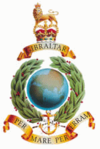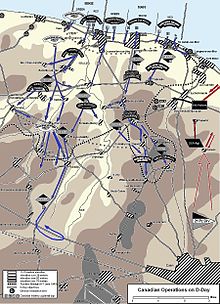- No. 48 (Royal Marine) Commando
-
No. 48 (Royal Marine) Commando 
Cap Badge of the Royal MarinesActive 1944–1946 Country United Kingdom Branch Royal Marines Type Commando Role Coastal raiding force
Assault InfantrySize One battalion Part of 4th Special Service Brigade Nickname Four Eight Motto Per Mare Per Terram (By Sea By Land) (Latin) March Quick - A Life on the Ocean Wave
Slow - PreobrajenskyCommanders Notable
commandersLieutenant Colonel James Moulton Insignia Combined Operations Shoulder Patch 
No. 48 (Royal Marine) Commando was a Royal Marine battalion size formation in the British Commandos, formed in 1944 during the Second World War. No. 48 Commando was assigned to the 4th Special Service Brigade and served in North West Europe, taking part in the Normandy Landings, operations around Ostend and Antwerp before being disbanded in January 1946
Contents
Background
The British Commandos were formed in 1940, by the order of Winston Churchill the British Prime Minister. He called for specially trained troops that would "develop a reign of terror down the enemy coast".[1] At first they were a small force of volunteers who carried out small raids against enemy occupied territory, [2] but by 1943 there role had changed into lightly equipped assault Infantry which specialised in spearheading amphibious landings.[3]
The man selected as the overall commander of the force was Admiral Sir Roger Keyes himself a veteran of the landings at Galipoli and the Zeebrugge raid in the First World War.[4] Initially the Commandos were a British Army formation the first Royal Marine Commando was formed in 1942.[5] The Royal Marine Commandos like all British Commandos went through the six week intensive commando course at Achnacarry. The course in the Scottish Highlands concentrated on fitness, speed marches, weapons training, map reading, climbing, small boat operations and demolitions both by day and by night.[6] In 1943 the commando formation had been standardised, into a small headquarters,five fighting Troops, a Heavy Weapons troop and a signals platoon. The fighting Troops consisted of 65 all ranks divided into two 30 man sections which in turn were divided into three ten man sub sections. The Heavy Weapons Troop was made up of 3 inch Mortar and Vickers machine gun teams.[7]
Operations
No. 48 (Royal Marine) Commando was the last commando unit formed during the Second World War in March 1944. It was formed by the conversion of the 7th Royal Marine Battalion and the Mobile Naval Base Defence Organisations (MNBDOs) defence battalions to commando duties. Under the command of Lieutenant Colonel James Moulton it carried out a shortened commando course at Achnacarry and then joined the all Royal Marine 4th Special Service Brigade alongside No. 41, No. 46 and No. 47 (Royal Marine) Commandos.[8]
Assigned to the Normandy landings 4th Special Service Brigade was given the task to seize a number of coastal villages, including Luc-sur-Mer, St. Aubin-sur-Mer Langrune-sur-Mer. They then had to push inland and capture the heavily fortified strong point near the radar station at Douvres. They were required to hold on for 48 hours before they were relieved.[9]
Landing on the Canadian Juno Beach No. 48 (Royal Marine) Commando was the first Commando unit to land near Saint-Aubin-sur-Mer and started the assault on Langrune-sur-Mer which was liberated after heavy fighting and severe losses. They then held a position awaiting reinforcement and equipment to land.[9]
The rest of 4th Special Service Brigade having landed No. 48 (Royal Marine) Commando carried out two attacks to take a hill near the village of Dozule. After the failure of both attacks No. 48 was reinforced by No. 46 and No. 47 Commandos. Reinforced No.48 Commando bypassed the village of Dozule to occupy the high ground at point 120, in the process cutting off a number of retreating Germans and destroying their vehicles.[9]
No.4 Special Service Brigade instead of being withdrawn after 48 hours continued in the Allied advance to the Seine. On route liberating Pont l'Eveque, Saint-Maclou, Pavilly, Yerville, Motteville, Yvetot, Bermonville and Valmont before coming out of the line on 18 August 1944.[9]
Battle of the Scheldt
4th Special Service Brigade returned to the front line to take part in the Battle of the Scheldt and Operation Infatuate in November 1944, tasked with the liberation of the island of Walcheren.
On 1 November No. 48 Commando landed in the South from tank landing craft under German shell fire captured their first objective a row of concrete gun emplacements, on the southern shoulder of the gap and then moved on to their next objective a radar station that had been abandoned by the German defenders. Their next objective an artillery battery was assaulted by Y Troop which resulted in all the Troop being either killed or wounded before they could reach it. Calling for naval gunfire support from H.M.S. Roberts and 2nd Canadian Division the position was next assaulted by Z Troop. Z Troop's assault also failed with half of them being killed or wounded by German mortar fire. The position was again targeted by the 2nd Canadian artillery and RAF rocket firing Hawker Typhoons. Assaulted again by No. 48 Commando the battery was eventually captured and 100 Germans made prisoner of war. No. 48 Commando's next objective was the capture of Zouteland, which was planned for 2 November. The attack started at dawn following a bombardment from H.M.S. Erebus the garrison surrendered after two hours of fighting.[10]
Following the Battle of the Scheldt No. 48 Commando raided across the Maas River in Holland and then took part in the army of occupation in Germany.
Legacy
No. 48 (Royal Marine) Commando together with all the army commandos and some Royal Marine commandos was disbanded in 1946 and the commando role was taken over by the Royal Marines.[11] However the present day Parachute Regiment, Special Air Service and Special Boat Service can all trace their origins to the Commandos.[12][13][14]
Battle honours
The following Battle honours were awarded to the British Commandos during the Second World War.[15]
- Adriatic
- Alethangyaw
- Aller
- Anzio
- Argenta Gap
- Burma 1943–45
- Crete
- Dieppe
- Dives Crossing
- Djebel Choucha
- Flushing
- Greece 1944–45
- Italy 1943–45
- Kangaw
- Landing at Porto San Venere
- Landing in Sicily
- Leese
- Litani
- Madagascar
- Middle East 1941, 1942, 1944
- Monte Ornito
- Myebon
- Normandy Landing
- North Africa 1941–43
- North-West Europe 1942, 1944–1945
- Norway 1941
- Pursuit to Messina
- Rhine
- St. Nazaire
- Salerno
- Sedjenane 1
- Sicily 1943
- Steamroller Farm
- Syria 1941
- Termoli
- Vaagso
- Valli di Comacchio
- Westkapelle
References
- Notes
- ^ Chappell, p.5
- ^ Chappell, p.3
- ^ Moreman, p.8
- ^ Chappell, p.6
- ^ Fowler, p.5
- ^ van der Bijl, p.12
- ^ van der Bijl, p.28
- ^ Moreman, p.94
- ^ a b c d "No. 48 Commando". Modern day commando. http://www.modern-day-commando.com/48-Commando-RM.html. Retrieved 7 May 2010.
- ^ "48 cdo Walcheren". Modern day commando. http://www.modern-day-commando.com/48-cdo-Walcheren.html. Retrieved 7 May 2010.
- ^ Lord & Graham, pp.216–317
- ^ Otway, pp.31–32
- ^ Breuer, pp.46–47
- ^ Molinari, p.22
- ^ Moreman, p.94
- Bibliography
- van der Bijl, Nick (2006). No. 10 Inter-Allied Commando 1942-45. Osprey Publishing. ISBN 1841769991.
- Chappell, Mike (1996). Army Commandos 1940-45. Osprey Publishing. ISBN 185532579925799.
- Fowler, Will (2009). Royal Marine Commando 1950-82: From Korea to the Falklands. Osprey Publishing. ISBN 1846033721.
- Haining, Peter (2006). The banzai hunters: the forgotten armada of little ships that defeated the Japanese, 1944-45. Robson. ISBN 1861059418.
- Moreman, Timothy Robert (2006). British Commandos 1940-46. Osprey Publishing. ISBN 184176986X.
- Neilands, Robin (2005). The Dieppe Raid. Indiana University Press. ISBN 0253347815.
- Shortt, James; McBride, Angus (1981). The Special Air Service. Osprey Publishing. ISBN 0850453968.
- Tomblin, Barbara (2004). With utmost spirit: Allied naval operations in the Mediterranean, 1942-1945. University Press of Kentucky. ISBN 0813123380.
 Commando sized units of the Royal Marines
Commando sized units of the Royal MarinesCurrent Units: 40 Commando · 42 Commando · 45 Commando · Fleet Protection Group Royal Marines · 30 Commando Information Exploitation Group · 1 Assault Group Royal MarinesFormer Units: 30 Commando · 41 Commando · 43 Commando · 44 Commando · 46 Commando · 47 Commando · 48 Commando
Categories:- Military units and formations established in 1944
- Military units and formations disestablished in 1946
- Royal Marine formations and units
- British Commandos
Wikimedia Foundation. 2010.


